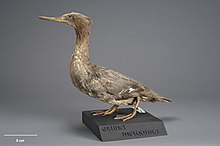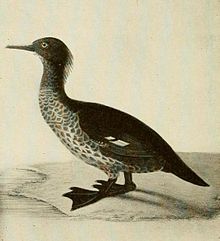The New Zealand merganser (Mergus australis) (Māori: Miuweka),[3] also known as Auckland merganser or Auckland Islands merganser, was a typical merganser which is now extinct.
| New Zealand merganser Temporal range: Late Holocene
| |
|---|---|

| |
| Stuffed specimen from 1902 | |
| Scientific classification | |
| Domain: | Eukaryota |
| Kingdom: | Animalia |
| Phylum: | Chordata |
| Class: | Aves |
| Order: | Anseriformes |
| Family: | Anatidae |
| Genus: | Mergus |
| Species: | †M. australis
|
| Binomial name | |
| †Mergus australis | |



Description edit
This duck was similar in size to the red-breasted merganser (Mergus serrator). The adult male had a dark reddish-brown head, crest and neck, with bluish black mantle and tail and slate grey wings.[4] The female was slightly smaller with a shorter crest.
History edit
This bird's Māori name was miuweka.[2] It was first collected when a French expedition led by the explorer Jules Dumont d'Urville on the ships L'Astrolabe and La Zelee visited the Auckland Islands in 1840. Its decline was caused by a combination of hunting and predation by introduced mammals.[5] The bird was not flightless, but rather hard to flush; it preferred to hide between rocks when pursued. The last sighting was of a pair shot on January 9, 1902. It was not found in a 1909 search, and a thorough 1972/1973 exploration of possible habitat concluded that it was long extinct.[6]
Subsequent fossil discoveries suggest that this merganser was previously resident in the South Island, and on Stewart Island/Rakiura in New Zealand. Fossils of a subspecies or closely related species have also been found on the Chatham Islands. There exists a short remark mentioning "a merganser" found on Campbell Island,[7] but this may just as well refer to the semi-marine Campbell teal which is otherwise missing in McCormick's notes: he only mentions the Pacific black duck ("a New Zealand species of duck").[8]
References edit
- ^ BirdLife International (2016). "Mergus australis". IUCN Red List of Threatened Species. 2016: e.T22680496A92864737. doi:10.2305/IUCN.UK.2016-3.RLTS.T22680496A92864737.en. Retrieved 11 November 2021.
- ^ a b "Mergus australis. NZTCS". nztcs.org.nz. Retrieved 3 April 2023.
- ^ "Auckland Island merganser | Miuweka | New Zealand Birds Online". nzbirdsonline.org.nz. Retrieved 2023-11-26.
- ^ Tennyson, Alan J. D. (2006). Extinct birds of New Zealand. Paul Martinson. Wellington, N.Z.: Te Papa Press. p. 54. ISBN 978-0-909010-21-8. OCLC 80016906.
- ^ Russell, James; Horn, Stephen R.; Miskelly, Colin M.; Sagar, Rachael; Taylor, Rowland H. (2020). "Introduced land mammals and their impacts on the birds of the subantarctic Auckland Islands". Notornis. 67 (1): 247–268.
- ^ Williams, G. R. & Weller, M. W.. (1974): Unsuccessful search for the Auckland Islands Merganser (Mergus australis). Notornis 21(3): 246–249. PDF fulltext
- ^ McCormick, Robert (1842): A sketch of the Antarctic regions, embracing a few passing remarks, geographical and ornithological. Tasmanian Journal of Natural Sciences 1(4): 241–247. PDF fulltext
- ^ * Southern Merganser. Mergus australis. by Paul Martinson. Artwork produced for the book Extinct Birds of New Zealand, by Alan Tennyson, Te Papa Press, Wellington, 2006

